On the trail of Britain's WWII 'explosive' beauty spots
- Published
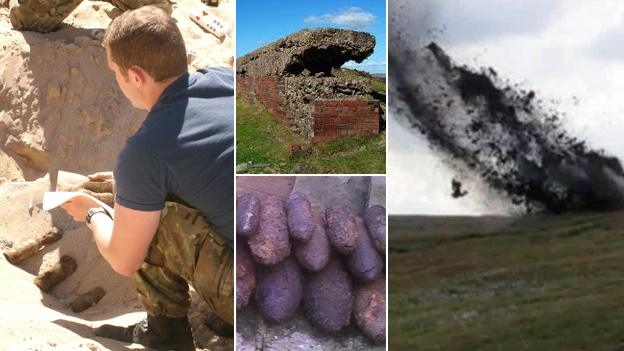
Britain is a land of rolling hills, rugged moors and spectacular coastline, which millions of us enjoy exploring.
But some of these idyllic spots hide potentially explosive secrets.
Every year, unsuspecting members of the public stumble upon dozens of undetonated shells and bombs, most dating back to World War II.
So what happened in these remote places during the war? And how much do we know about the people who lived and worked there?
WAR ON LANGSETT MOORS
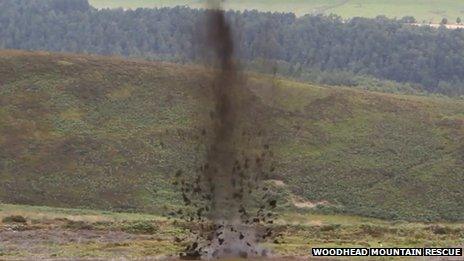
Bomb disposal experts detonated four devices on the moors in autumn 2012
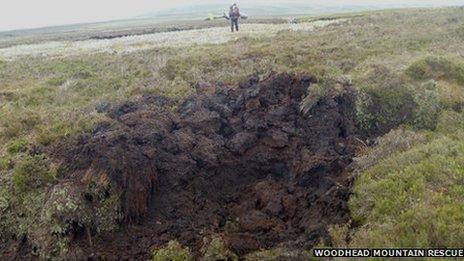
Some of the shells contained enough explosives to make a room-size crater
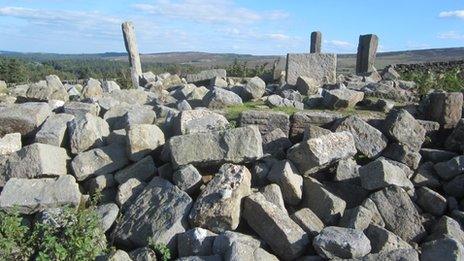
An empty farm overlooking the reservoir was used for target practice
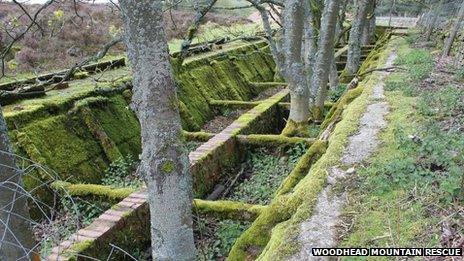
Tank washes were used to clear peat from the vehicle's tracks
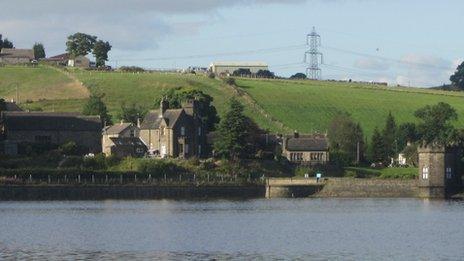
Troops from as far away as the US and Canada trained on the moors

This weight was part of the catenary defence, which protected the dam
In 1941, hundreds of soldiers began descending upon an isolated part of the Peak District.
Troops fired chemical weapons, tanks thundered along rubble tracks, and abandoned farm buildings were bombarded with bullets and mortars.
What they left behind still has the "potential to kill".
Mountain rescue volunteer Milo Milinkovic has been helping to clear what remains of the ordnance left on the moors around Langsett and Midhope.
"They've been there 70 years plus, so they've eroded - markings can't be seen and fuse cases are corroded. You can't see anything that will guarantee it's safe."
"The shells could make a room sized crater, so as far as an individual is concerned if you activated it, it's going to kill you and anyone near you."
As well as helping make the area safe, Mr Milinkovic is part of a team working to unearth the little-known wartime history of the area.
Langsett, he said, was a "totally different place" during the war.
"There were soldiers billeted to protect the dams, and there were an awful lot of troops stationed here.
"The dams were defended by searchlights, guns, and things called catenary defences - which was basically a metal curtain to stop planes being able to run in and bomb them.
"At the same time we were training our own tank regiments, and Canadian, American, Polish, French troops for what ultimately became the D-Day landings."
Access to the moors was severely restricted, and life changed dramatically for the few hundred people living in the surrounding farming communities.
Soldiers stayed in houses belonging to the water board and, as the camp grew, a NAAFI (Navy, Army and Air Force Institute) was built. Staffed by local women, it provided bars, shops and a place for troops to eat.
Local people often adapted to the army's constant presence in idiosyncratic ways.
Mr Milinkovic said: "One of the stories I have heard is about a then young lady who lived in a property that was within the secure area.
"She used to go the [Girl] Guides, but to come back home had to cross the dam wall where there was a sentry post.
Safety warnings
"She was a little bit put off by the soldiers challenging her, so as she and her friends approached they would stamp their feet loudly so the soldiers knew they were coming in plenty of time."
"It doesn't seem a lot, but if you're out in blackout conditions, it would have been quite frightening for the girls to have someone jump out at them."
Mr Milinkovic said he had also heard stories about young men sledging during the Blitz, and seeing German bombers flying over with aircrew visible in the turrets.
"There are lots of little examples of things like that.
"It was an interesting time, that's just never been recorded, and it's worthy of that story being told."
The team has received a £7,400 grant from the Heritage Lottery Fund, which will be used to put up signage about the moors' role in the war, and safety warnings about ordnance.
THE NEW FOREST'S ROLE IN WWII
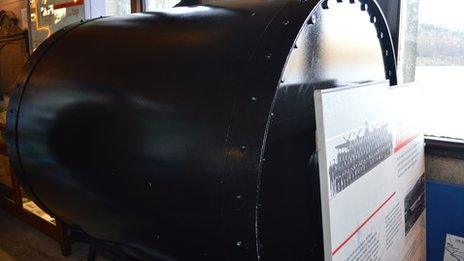
The Dambusters' "Upkeep" bouncing bomb was tested in the New Forest

Concrete target blocks were illuminated for aircraft to use as target practice
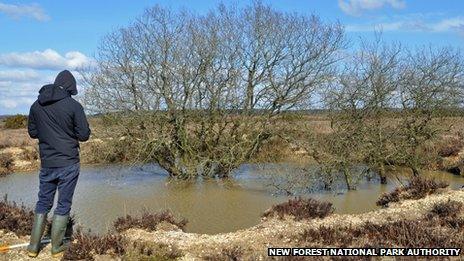
Some bomb craters are now used as watering holes by the New Forest's wildlife

Arthur Poore flew secret missions over Ashley Walk - testing Tallboy bombs
A tranquil area of what is now the New Forest National Park was used to test some of the biggest and most destructive weapons of WWII.
The 12,000lb Tallboy and the 22,000lb Grand Slam "earthquake" bombs were designed to hit targets with pinpoint accuracy, and cause huge damage.
"The bombs would penetrate deep into the ground before exploding, with the shock wave devastating nearby structures and foundations," said Gareth Owen from the park authority.
"Local residents were told to keep their windows open, but not the reason why [to prevent them shattering]."
Developed by Barnes Wallis - the inventor of the Dambusters' bouncing bomb - the top-secret projects in Hampshire were part of a shift away from large-scale carpet bombing.
Viewed from above, the landscape at Ashley Walk is littered with craters and the remains of large chalk targets.
One former RAF pilot - 92-year-old Arthur Poore, who joined the Dambusters' 617 Squadron after the raids on Germany's Ruhr dams - flew test missions there.
These involved dropping Tallboys on reinforced concrete buildings.
He said: "There were huge U-boat pens the size of three football pitches at Brest and the French ports. They had twelve feet of concrete on top so that if you had a direct hit with a 4,000lb bomb, it would just bounce off.
"So to experiment, they built a small building in this aerodrome [Ashley Walk] with ten feet of concrete on top and squadron bombers came along and dropped their bombs to see what happened."
The results showed the Tallboy's shock waves could cause extensive damage to a hardened or underground building, even if it was not a direct hit.
They were later used to great effect destroying rail tunnels and heavily fortified V-2 bunkers.
A 9ft (2.7m) reinforced wall was also built at Ashley walk to test Barnes Wallis' most famous invention - the bouncing bomb.
It is generally believed the Upkeep bomb was not used after the Dambusters' raids - but tests were carried out in the New Forest in 1943 to see if the device could be adapted to breach sea wall defences in France.
Fragments of ordnance are often found in the area, although it is rare for large-scale bombs to be found intact.
However, last year two 500lb objects were unearthed - they turned out to be WWII training devices.
Mr Owen is working on the New Forest Remembers WWII project, external which aims to chart the wartime history of the area.
During WWII, an area of the New Forest National Park was used to test advances in bouncing bomb technology.
He said: "Ashley Walk is probably still strewn with shards and remains of Second World War bombs, which, along with archive reports and photos, really sheds light on this period.
"It was a top secret testing area, so even local people weren't meant to fully know what was going on.
"We knew before this project began that Ashley Walk was an important site, but we didn't realise the sheer scale and number of bombs dropped and how important it was."
Other parts of the New Forest were also used extensively during the war.
Twelve airfields were built within the park, with commandos based along the Beaulieu River - the last part of England many of them saw before they left for occupied France.
COMMANDO TRAINING IN THE SCOTTISH HIGHLANDS
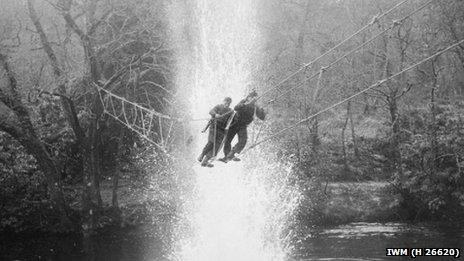
Troops based at Achnacarry were warned about the severity of the training
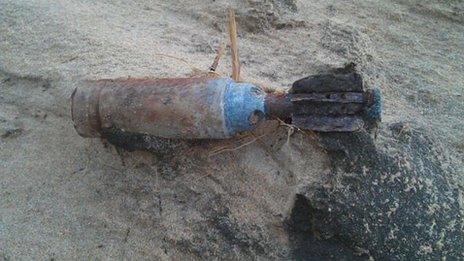
Coastguard Tom Jackson found this mortar on the beach at Camas an Lighe
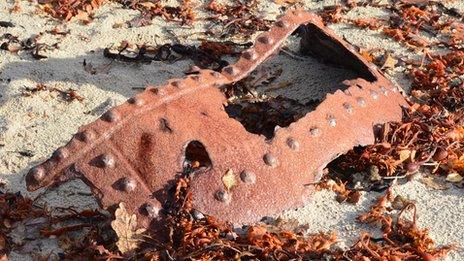
Other evidence of wartime activity includes fragments of sea mine casings
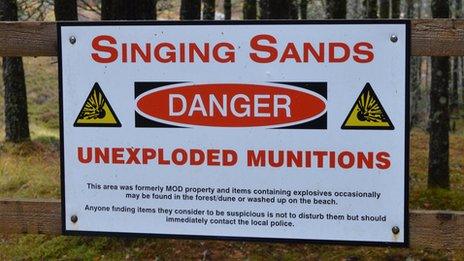
Signs warn visitors of the area's WWII history
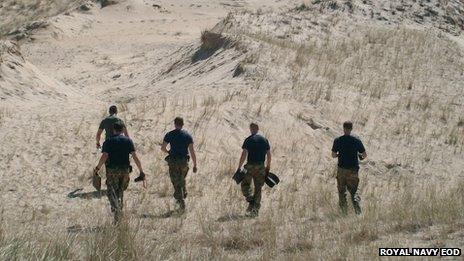
In 2012, WWII shells were found by members of the Royal Navy EOD team
US boatman Joseph "Eddie" McCann was just 15 when in 1944 he led a small boat carrying troops onto the beaches of Normandy.
"We thought it might be an easy one - you're always hoping for an easy one. I wasn't really prepared for what come about in the next 100 yards. It was unbelievable," he said.
"We lost in that first wave over 2,000 men. We got hit with body parts, heads come flying, guts start stacking up all over the beach, along with the bodies - it's hard to really talk about it, when you see your brothers being mangled."
The D-Day landings of WWII were key to the liberation of German-occupied western Europe. Although bloody, brutal and chaotic, they had been rehearsed at length.
Training took place around the UK, including at Lochaber in the Scottish Highlands, where troops dodged live bullets as they practised beach assaults.
Commandos were based at Achnacarry, near Fort William, with Special Operations Executive (SOE) at Lochailort, near Mallaig.
Local coastguard Craig Burton said: "Camas an Lighe, more popularly known as Singing Sands, on the north coast bears witness to that history.
"The beaches and their dune system were used for live fire landings training prior to many operations, including D-Day.
"One in particular, known locally as number three beach, contains most of the evidence."
He said: "Operations involved using fixed-height machine guns, fired above the troops as they landed.
"They returned fire as they advanced up the beach using rifles, machine guns, mortars, grenades and other ordnance.
"They were even reputed to be able to call in air support to attack a target painted on a rock face at the back of the beach."
He added: "Today, as the sands continue to move around, they regularly reveal evidence of all this activity. Spent and live rifle and pistol bullets have been found in abundance.
"High explosive, smoke, and, more worryingly, phosphorus mortar bombs and hand grenades turn up less frequently - although they cause quite a stir when they are placed on the bar at the local hotel or are handed in at the local police station."
'Shelled by accident'
Larger ordnance, such as bombs and shells, has not been found for a number of years - but other evidence of the military exercises is often uncovered, especially barbed wire and the folding cutters used to penetrate it.
Although there is a memorial at Spean Bridge to the commandos who trained in the Lochaber region, few accounts of life during the war have been recorded.
Mr Burton said one story he had heard was about a local postman being shelled by accident whilst trying to deliver the post to Gorteneorn.
He said: "Luckily, he decamped to the nearest ditch and used his own military training from WWI to time the shells - making his break to the next ditch between salvos.
"Both the postman and his post got through unharmed."
- Published28 March 2013

- Published12 September 2012
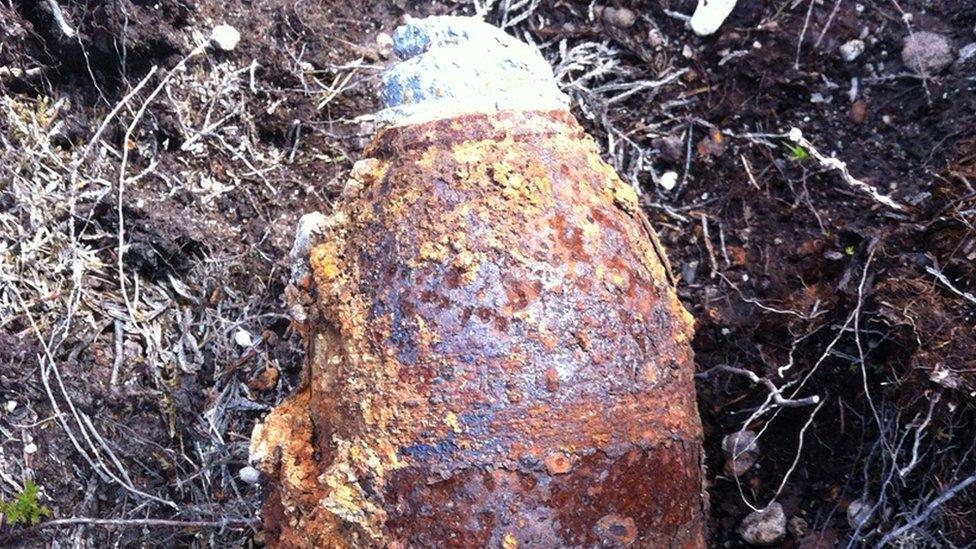
- Published22 July 2012
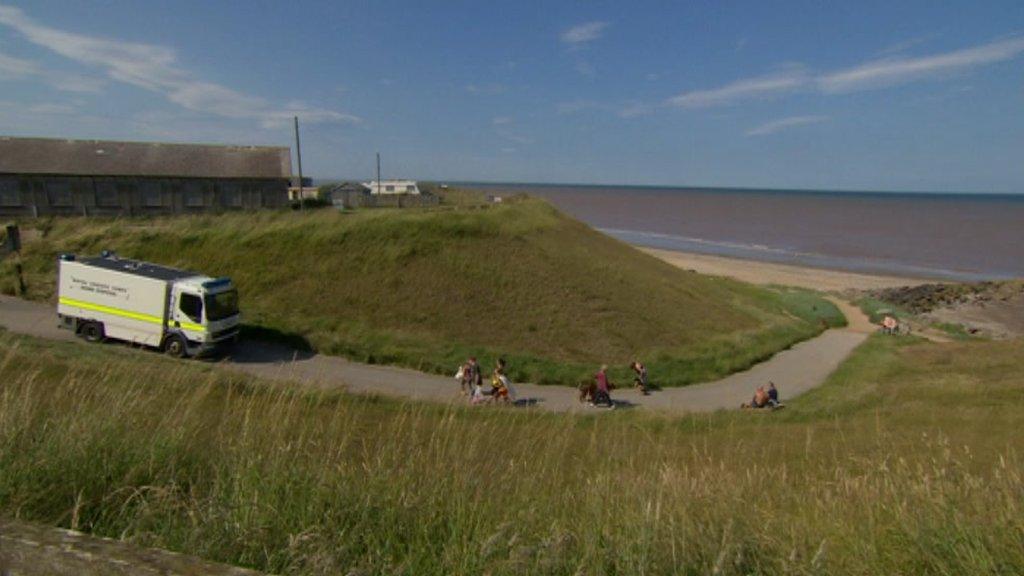
- Published22 February 2012
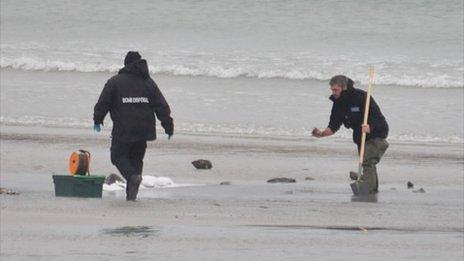
- Published2 May 2011
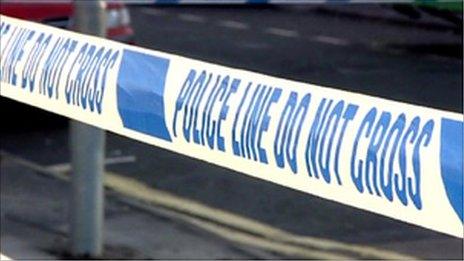
- Published3 February 2011